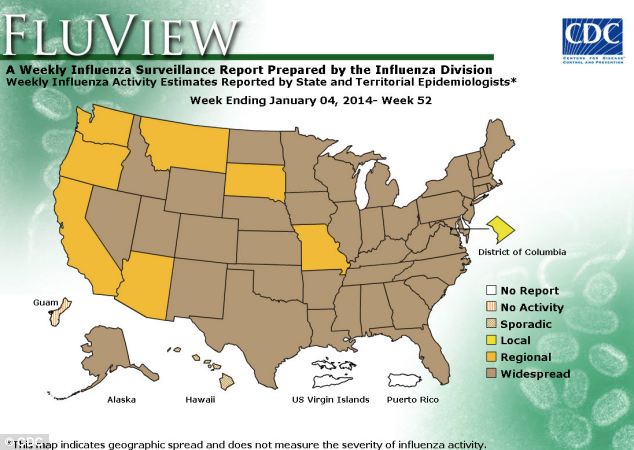
That's five fewer states than the previous week, lending a bit of hope that the epidemic has begun to wane since those states with decreased activity, such as Florida and South Carolina, were also where the flu first started growing at a terrifying pace.
"It may be decreasing in some areas, but that's hard to predict," CDC Director Dr. Thomas Frieden said. "Trends only in the next week or two will show whether we have in fact crossed the peak."
But the positive news was tempered by the startling figure that 47 states now report widespread flu activity.
The only states not on that list are Hawaii, California and Mississippi.
The death toll continues to rise with 21 children nationally having passed away from the flu, which has hit harder and earlier than previous years, USA Today said.
Officials in New York City are warning that the 'severe' strain has reached epidemic proportions across the city.
New York health officials advised the public to get flu shots in an attempt to limit the impact of the virus as five per cent of patients in city emergency rooms report influenza-like symptoms, compared to two per cent of patients last year.
'Our message is it's still not too late to get your flu shot,' said New York City Health Commissioner Dr. Thomas Farley.
'If you haven't gotten the flu yet and you haven't gotten your flu shot yet, you could still get it.

'So we're seeing plenty of cases of flu and plenty of people sick with flu,' he said.
'Anybody that doesn't think so is just missing an opportunity to protect themselves. There's no guarantees in life.
New York Mayor Michael Bloomberg got a flu injection in October but still got ill last month. He said that won't stop him from continuing to get vaccinated every year, CBS 2 reported.
'You can take a flu shot, walk across the street and get hit by a car. It doesn't mean you shouldn't take your flu shot,' Bloomberg said.
The National Institute of Allergy and Infectious Diseases said the outbreak could be the worst since 2003-2004.
'We are into what would classically be described as a flu epidemic,' the Institute's Director, Anthony Fauci, told Agence France Presse.

An entire school district in Oklahoma on Thursday was forced to close until Monday since 25 percent of its students were ill, ABC News said. Eight people throughout Oklahoma have died from the flu since October.
Among the 21 children who have died are Tahila Johnson, 6, from Dallas, Texas and Joshua Polehna, 15, from Fenton, Michigan.
Tahila was found dead in her bed, the day after her family had taken her to the emergency room with flu-like symptoms, including fever and chills.
Family members are questioning whether she should have been sent home Monday from Dallas Regional Medical Center in Mesquite.
According to a police report, her family took her in for treatment and was given a flu diagnosis and a prescription for Zyrtec. The next morning, the girl's grandmother found her dead.
The Michigan Department of Community Health has said that Polenha had no underlying health condition.
The 2012-2013 flu vaccine protects against three different flu viruses: an H3N2 virus, an influenza B virus and the H1N1 virus.
Google, which tracks national flu trends according to the number of times people ask about the flu, rates the current outbreak as 'intense.'
Although patients are being advised to seek medical attention if they are sick and have clear symptoms, emergency rooms are so overloaded that hospitals are instructing people to see their primary care physicians first.
'It's about five weeks ahead of the average flu season,' said Lyn Finelli, lead of the surveillance and response team that monitors influenza for the CDC's National Center for Immunization and Respiratory Diseases. 'We haven't seen such an early season since 2003 to 2004.'
During that flu season, Joe Lastinger's daughter Emily, 3, died only five days after coming down with the flu in late January.
'That was the first really bad season for children in a while,' said Lastinger, 40. 'For whatever reason that's not well understood, it affected her and it killed her.'
In that season, illnesses peaked in early to mid-December, with flu-related pneumonia and deaths peaking in early January.
That season was considered a 'moderately severe' season for flu, and ended in mid-February.
It's still too early to tell how bad this year's flu season will get.
During the 2010-2011 flu season, the CDC reports vaccine's were effective four about 60 percent for all age groups combined.
While there were then reports of vaccinated people developing laboratory-confirmed flu strains, CDC officials said it's not yet possible to know if this year's trends match up though they are 'watching the situation closely.'
Those officials also noted that this year's vaccines seem to be a good match for the two strains of influenza A and one of influenza B circulating.
The H3N2 strain is dominant this year, and it can cause more serious illnesses.
Flu seasons vary widely in severity with some year's totaling up to 200,000 hospitalized and between 3,000 to 49,000 dead



Reader Comments
to our Newsletter